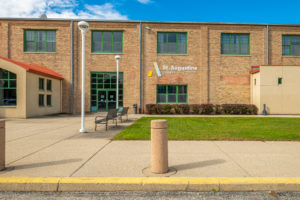Respiratory Care Practitioner vs. Registered Respiratory Therapist

February 27, 2024
If you’re looking into a career in respiratory care, you might be wondering about the difference between a Respiratory Care Practitioner (RCP) and a Registered Respiratory Therapist (RRT). Both play important roles in healthcare, focusing on patients with breathing problems. This guide aims to clarify the differences in these careers, with a special focus on the opportunities available through St. Augustine College’s Associate of Applied Science Degree in Respiratory Therapy.
What Is A RCP and What Do They Do?
A Respiratory Care Practitioner (RCP) is a healthcare professional with specialized training in the assessment, diagnosis, treatment, and management of patients with respiratory disorders. RCPs often have a broader scope of practice, including more advanced diagnostic and therapeutic responsibilities, depending on their level of training and the regulations of their practicing region. Here’s a closer look at the role of Respiratory Care Practitioners in healthcare.
Key Responsibilities of a Respiratory Care Practitioner
- Diagnostic Testing: RCPs perform and analyze tests to diagnose respiratory conditions. This can include pulmonary function tests, arterial blood gas analyses, and other diagnostic procedures that assess lung capacity and oxygen levels.
- Treatment Planning and Management: They develop and manage treatment plans for patients with acute and chronic respiratory conditions, such as asthma, emphysema, and COPD, ensuring treatments are effective and adjusted as needed.
- Emergency Respiratory Care: RCPs provide critical care in emergencies, such as during a respiratory crisis or when a patient requires advanced airway management.
- Patient Education: Educating patients and their families about respiratory conditions and how to manage them is a crucial part of an RCP‘s job. This includes instructing on the use of medications, inhalers, and equipment like CPAP machines.
- Collaboration with Healthcare Teams: RCPs work closely with doctors, nurses, and other healthcare professionals to deliver comprehensive care, often playing a key role in interdisciplinary teams.
What Is an RRT and What Do They Do?
An RRT, or Registered Respiratory Therapist, is a specialized healthcare professional who focuses on providing care and treatment for patients with breathing or other cardiopulmonary disorders. RRTs are key players in healthcare teams, working closely with doctors and nurses to ensure patients receive the best possible care for their respiratory conditions. Let’s break down what Registered Respiratory Therapists do and the important role they play in patient health.
Key Responsibilities of a Registered Respiratory Therapist
- Patient Assessment: RRTs start by evaluating patients who have difficulty breathing or suffer from other respiratory conditions. They review medical histories, conduct physical examinations, and perform diagnostic tests to determine the best course of treatment.
- Creating Care Plans: Based on their assessments, RRTs work with the healthcare team to develop and implement care plans tailored to each patient’s needs.
- Managing Respiratory Equipment: They are trained in managing ventilators and other breathing devices, ensuring patients receive the right amount of oxygen, and assisting with mechanical ventilation when necessary.
- Conducting Therapies: RRTs perform various respiratory therapies to help patients improve lung function. This includes administering medications in aerosol form, performing chest physiotherapy, and teaching breathing exercises.
- Educating Patients and Families: A crucial part of an RRT’s job is to educate patients and their families on managing respiratory conditions at home, including the use of inhalers, nebulizers, and oxygen therapy equipment.
Distinguishing Between RCPs and RRTs
While both roles are critical in respiratory care, the journey to becoming an RCP or RRT involves distinct educational and training paths.
- Education and Training: An RCP’s journey begins with a bachelor’s degree in a science-related field, followed by medical school, resulting in an M.D. or D.O. degree. Postgraduate training includes a residency in internal medicine and a fellowship in pulmonology. Conversely, through St. Augustine College an RRT’s path requires an associate degree in respiratory therapy, complemented by hands-on training and certification exams, aligning with the immediate needs of the healthcare industry.
- Licensing and Certification: RCPs must navigate the rigorous process of obtaining a medical license and may pursue board certification in pulmonary medicine. RRTs, on the other hand, achieve their credential through a series of exams administered by the National Board for Respiratory Care (NBRC), ensuring their expertise in the field.
Where Do RCPs and RRTs Work?
While there is significant overlap in where Respiratory Care Practitioners and Registered Respiratory Therapists work, certain distinctions can be drawn based on their responsibilities and level of expertise.
Work Environments of Registered Respiratory Therapists
- Hospitals: RRTs are in various departments, including emergency rooms, intensive care units, neonatal/pediatric units, and pulmonary departments, providing critical care, mechanical ventilation, and emergency respiratory support.
- Outpatient Clinics: They offer therapeutic services and conduct pulmonary function tests to outpatients dealing with chronic respiratory conditions.
- Home Health Agencies: RRTs provide care to patients in their homes, helping manage long-term respiratory conditions or providing home ventilator support.
- Pulmonary Rehabilitation Programs: RRTs working in these settings help patients improve lung function through exercise and education.
- Sleep Disorder Centers: Some RRTs specialize in sleep medicine, helping diagnose and treat sleep-related breathing disorders like sleep apnea.
Work Environments of Respiratory Care Practitioners
- Hospitals: Like RRTs, RCPs work in various hospital departments but are also involved in specialized units due to their advanced medical training. Their role includes leading respiratory care teams or managing complex cases.
- Private Practices and Physician Offices: RCPs with medical degrees may work closely with pulmonologists or other specialists in a private practice setting, focusing on diagnosing and managing complex respiratory conditions.
- Research and Educational Institutions: Some RCPs engage in clinical research, contributing to the development of new treatments and therapies. They may also work in academic settings, training future respiratory therapists.
- Specialty Care Facilities: These include long-term care facilities, specialized respiratory care centers, and advanced pulmonary rehabilitation facilities where patients receive focused treatment for chronic or severe respiratory diseases.
Starting Your Career at St. Augustine College
At St. Augustine College, we’re here to help you start your career in respiratory care. We focus on giving you practical experience and the knowledge to excel in your chosen career path.
Take the first step towards a fulfilling career that makes a real difference in people’s lives. Reach out to St. Augustine College today to learn more about our Associate of Applied Science Degree in Respiratory Therapy program. Apply today, and start your journey to transforming lives through better breathing. Your future in healthcare begins here, at St. Augustine College.




